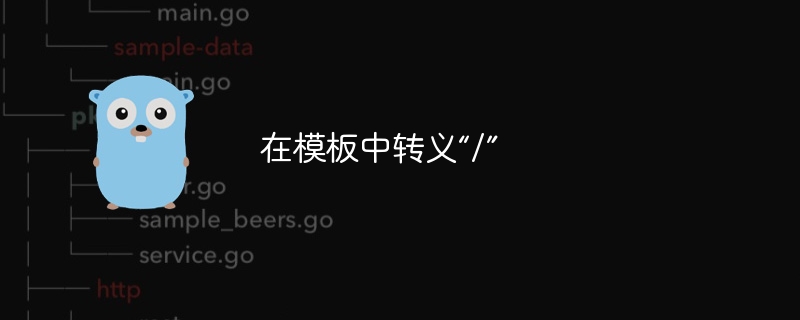Escape '/' in templates

I want to pass a string like "avatars/avatar.png", but when I pass it to the template, I get character escapes. So I wrote a function that is passed to the template:
var tpl *template.Template
func init() {
tpl = template.Must(template.ParseGlob("1Forum/static/html/*.html"))
tpl = tpl.Funcs(template.FuncMap{
"unescape": func(s string) string {
unescaped, err := url.PathUnescape(s)
if err != nil {
return s
}
return unescaped
},
})
}
{{unescape .User.Avatar}}But I still get "undefined function 'unescape'". Is unescape not defined?
"net/url" has been imported.
Correct answer
unescape is not defined?
Technically no. You did define it, but you did so too late. Whether a function is defined is checked during parsing, not during execution. You have parseglob and then you do tpl.func(...) . It's not normal.
Instead do this:
func init() {
tpl = template.Must(template.New("t").Funcs(template.FuncMap{
"unescape": func(s string) string {
unescaped, err := url.PathUnescape(s)
if err != nil {
return s
}
return unescaped
},
}).ParseGlob("1Forum/static/html/*.html"))
}
Please note that escaping is a safe feature and its occurrence depends on the context you are using the data in, and unescape probably won't help you "cheat" your way around, since the escaping will be done on the output of unescape, not its input.
In other words, when you do {{unescape .}}, the parser may convert it to {{unescape . | urlescaper}} depending on the context (urlescaper is an internal escaping function). To avoid this, when you want to use a known safe string verbatim in a template, you should use input string instead of unescape.
See Playground Example.
For more information about context, escaping, typing strings, etc., read the package's documentation , everything is explained clearly.
The above is the detailed content of Escape '/' in templates. For more information, please follow other related articles on the PHP Chinese website!

Hot AI Tools

Undresser.AI Undress
AI-powered app for creating realistic nude photos

AI Clothes Remover
Online AI tool for removing clothes from photos.

Undress AI Tool
Undress images for free

Clothoff.io
AI clothes remover

AI Hentai Generator
Generate AI Hentai for free.

Hot Article

Hot Tools

Notepad++7.3.1
Easy-to-use and free code editor

SublimeText3 Chinese version
Chinese version, very easy to use

Zend Studio 13.0.1
Powerful PHP integrated development environment

Dreamweaver CS6
Visual web development tools

SublimeText3 Mac version
God-level code editing software (SublimeText3)

Hot Topics
 How do you use the pprof tool to analyze Go performance?
Mar 21, 2025 pm 06:37 PM
How do you use the pprof tool to analyze Go performance?
Mar 21, 2025 pm 06:37 PM
The article explains how to use the pprof tool for analyzing Go performance, including enabling profiling, collecting data, and identifying common bottlenecks like CPU and memory issues.Character count: 159
 How do you write unit tests in Go?
Mar 21, 2025 pm 06:34 PM
How do you write unit tests in Go?
Mar 21, 2025 pm 06:34 PM
The article discusses writing unit tests in Go, covering best practices, mocking techniques, and tools for efficient test management.
 How do I write mock objects and stubs for testing in Go?
Mar 10, 2025 pm 05:38 PM
How do I write mock objects and stubs for testing in Go?
Mar 10, 2025 pm 05:38 PM
This article demonstrates creating mocks and stubs in Go for unit testing. It emphasizes using interfaces, provides examples of mock implementations, and discusses best practices like keeping mocks focused and using assertion libraries. The articl
 How can I define custom type constraints for generics in Go?
Mar 10, 2025 pm 03:20 PM
How can I define custom type constraints for generics in Go?
Mar 10, 2025 pm 03:20 PM
This article explores Go's custom type constraints for generics. It details how interfaces define minimum type requirements for generic functions, improving type safety and code reusability. The article also discusses limitations and best practices
 How can I use tracing tools to understand the execution flow of my Go applications?
Mar 10, 2025 pm 05:36 PM
How can I use tracing tools to understand the execution flow of my Go applications?
Mar 10, 2025 pm 05:36 PM
This article explores using tracing tools to analyze Go application execution flow. It discusses manual and automatic instrumentation techniques, comparing tools like Jaeger, Zipkin, and OpenTelemetry, and highlighting effective data visualization
 Explain the purpose of Go's reflect package. When would you use reflection? What are the performance implications?
Mar 25, 2025 am 11:17 AM
Explain the purpose of Go's reflect package. When would you use reflection? What are the performance implications?
Mar 25, 2025 am 11:17 AM
The article discusses Go's reflect package, used for runtime manipulation of code, beneficial for serialization, generic programming, and more. It warns of performance costs like slower execution and higher memory use, advising judicious use and best
 How do you use table-driven tests in Go?
Mar 21, 2025 pm 06:35 PM
How do you use table-driven tests in Go?
Mar 21, 2025 pm 06:35 PM
The article discusses using table-driven tests in Go, a method that uses a table of test cases to test functions with multiple inputs and outcomes. It highlights benefits like improved readability, reduced duplication, scalability, consistency, and a
 How do you specify dependencies in your go.mod file?
Mar 27, 2025 pm 07:14 PM
How do you specify dependencies in your go.mod file?
Mar 27, 2025 pm 07:14 PM
The article discusses managing Go module dependencies via go.mod, covering specification, updates, and conflict resolution. It emphasizes best practices like semantic versioning and regular updates.






